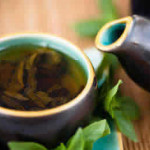Does Green Tea Raise or Lower Blood Pressure?
Green tea is commonly considered as healthy beverage. This is reasonable since it is rich in antioxidants and other essential nutrient for the body. But tea is tea, and it also some caffeine – even decaffeinated coffee (decaf coffee) is not 100 percent free of caffeine. And as well we know, caffeine can cause a sudden increase in blood pressure (BP). The effect is temporary, but some experts think that too much consumption of caffeine may cause increased risk of hypertension (though this issue is also still debatable). How about with green tea? Does it cause bad or good effect on your BP? Does it raise or lower your BP?
Generally, moderately drinking green tea can provide lots of health benefits. In healthy individuals, these benefits outweigh the risk of sudden kick-up in blood pressure.
Even this habit may help reduce the risk of developing high blood pressure (hypertension) and promote good health to your heart in longer term.
 Since green tea is rich in antioxidant, it is also considered as powerful agent to fight free radicals and that’s why many studies confirmed that drinking it moderately is linked with the lower risk of cancers.
Since green tea is rich in antioxidant, it is also considered as powerful agent to fight free radicals and that’s why many studies confirmed that drinking it moderately is linked with the lower risk of cancers.
For healthy people without hypertension, drinking this tea moderately is commonly recommended. It can be good for the health of the cardiovascular system, including for the heart and blood pressure – why?
It’s clear that having chronic high cholesterol (high bad cholesterol ‘LDL – Low Density Lipoprotein’) can put you at high risk of developing hypertension.
Fortunately, high cholesterol is preventable condition. It is often successfully prevented and treated with lifestyle approaches. And healthy diet is one of the keys of lifestyle approaches to prevent both high cholesterol and high blood pressure.
There are some healthy foods that can help boost HDL (good cholesterol) and lower LDL (bad cholesterol), and one of them is green tea.
Some research showed that drinking this tea is linked to the lower risk of high LDL. The key may be polyphenol in green tea. It may help block dietary cholesterol absorbed in the intestine.
Atherosclerosis is very bad for your blood pressure. It can decrease the diameter of artery where the blood flows. This decreased diameter means the narrowed way for your blood to flow. As a result, there will be more forces of blood against the artery walls, and your blood pressure can increase.
Even atherosclerosis can lead to a clogged artery – a serious condition that can cause stroke or heart attack, depending on where it occurs.
As well we know, overweight or obesity is one of factors that can increase your risk of developing hypertension. In fact, many obese people experience hypertension.
Green tea contains special substance called catechins that may help provide fat-burning effect. Furthermore, this may also help boost metabolism (having greater metabolic rate can help lose more pounds of your excessive weight if you are overweight).
While green tea may help reduce the risk of atherosclerosis, high cholesterol, and can be helpful to make excessive pounds of your weight melt away, but its caffeine content can be potential to cause a sudden increase in blood pressure – as noted before.
For healthy individuals, this may not be harmful, but it may be dangerous for individuals with hypertension.
There may be no single answer for the content of caffeine in a cup of green tea. First, the answer may vary from type to type. Secondly, the way on how to brew the tea also can affect.
But in general, a cup of green tea can contain about 15 to 75 mg of caffeine. Even according to Mayo Clinic, about 95 mg of caffeine can be found in a (8-0z) cup of green tea which can give impact in raising BP up to 3 to 14 points.
But if compared with other teas (such as oolong and black tea), green tea has the lowest caffeine content.
It is also richest in polyphenol (the major type of essential antioxidant found in tea).
Actually, all of these teas are made from the same plant called ‘Camellia sinensis’. The way on how to produce them is the key why they contain different properties. To make black tea, the leaves of Camellia sinensis are fully fermented.
The more fermented leaves, the higher content of caffeine and the lower content of antioxidants! Therefore, black tea is richest in caffeine and lowest in polyphenol. Oolong tea is partially fermented – and for green tea, it is prepared and produced from unfermented leaves.
See also how caffeine affects your blood pressure and the recommended dietary allowance for caffeine in here!
While it can give many health benefits, but too much consumption (high dose or about more than 5 cups a day) can be counterproductive – even this can be toxic and harmful for your health, according to Mayo Clinic.
So, you have to drink it in moderation. Generally, green tea is not recommended for children or pediatric use.
In healthy adults, drinking about 2-3 cups is the best recommendation to get the most health advantages of green tea – according to an article written and published in the official site of the University of Maryland Medical Center.



